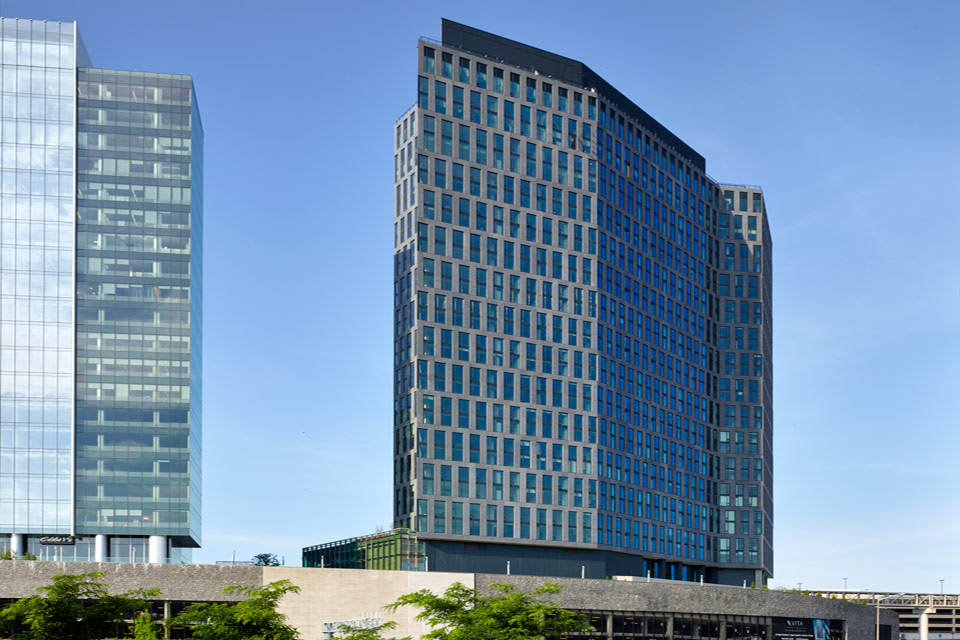[et_pb_section admin_label=”section”]
[et_pb_row admin_label=”row”]
[et_pb_column type=”4_4″]
[et_pb_text admin_label=”Text”]
Washington, D.C. has a vibrant architectural culture, not limited to the neoclassical masonry of government buildings and major museums. The upcoming Facades+AM conference gives the District design community a chance to share ideas on building envelopes’ contributions to sustainability and occupants’ quality of life.
Compressed into the morning of March 15 at the Washington Plaza Hotel, the nine-presentation event will address three essential themes in facade design: transparency, opacity, and connectivity. Gathering architects, specifiers, engineers, and others in the field, this Facades+AM is Washington, D.C.’s fourth annual event in the Facades+ series.
According to conference chair John Jackson, a senior facade consultant at Simpson Gumpertz & Heger, the conference’s regional focus allows “a nice balance of projects to showcase–projects that we might not see every day here in DC, but also projects right here in the District which are custom, inspirational, and innovative.” He added that a knowledge transfer from “big, cool, fun projects with endless budgets” to quotidian practice is a high priority. Each panel will include an architect/designer, a consultant/engineer, and a contractor/fabricator to foster interdisciplinary conversations.
Glass is the typical skin-type featured at Facades+ events and Jackson’s own specialty, but he made sure to include a broad range of facade types. The opening panel considers glass curtain walls and custom glazing systems. The second panel addresses the construction and performance of opaque walls, such as brick cavity walls, terra cotta, and metal panel rainscreens. The closing panel looks at connections between glass and opaque systems, which Jackson describes as often being a “no man’s land,” given the “ambiguity and lack of clarity of who ‘owns’ the design.”

(Courtesy Shalom Baranes Associates/Alan Karchmer)
Jackson anticipates lively discussion of new and innovative technologies that are advancing facade performance on multiple fronts. “The industry is constantly pushing greater improvement in the thermal performance of the envelope,” he said, and is now being more carefully looked at by code reviewers. Increasingly higher-performing building envelopes contribute to energy efficiency, occupant comfort, and control of condensation, particularly in humidified spaces.
In the buildings of today and the future, “we expect to see full thermally broken aluminum-framed curtain-wall systems, for example, and high-performance insulating glass with low-E coatings, argon-filling, etc.” New materials and technologies challenge clients to balance performance, cost, and risk, drawing on both predictive estimates and direct experience; though testing using industry standards such as ASTM and AAMA are incredibly valuable, he says, “nothing will ever replace Mother Nature and the test of time.”
The city poses its own unique set of climate and planning challenges. The mid-Atlantic climate of Washington, D.C. has wide temperature fluctuations from month to month and season to season, which requires careful attention to the design of exterior walls and hygrothermal performance. The swing seasons also offer ample opportunity for building users to enjoy fresh air from the outdoors with operable envelope elements, which are particularly popular in multifamily residential buildings, yet less so in commercial and institutional projects.
The District’s height limit also typically results in cast-in-place concrete as the structural system of choice, which results in limited building lateral movement under wind loads, for example, compared to tall and more flexible steel skyscrapers often found in other cities, which has an effect on the design of the facade joints. D.C. building owners, he adds, often with government end users, can also present unique challenges in other respects, including design of glazing systems for security requirements such as blast, forced entry, and ballistic resistance.
The conference website lists the speakers and topics, along with details on registration, sponsors, and the ten other Facades+ events across the US in 2018.
Bill Millard is a contributor to the AN, Oculus, Architect, Metals in Construction, LEAF Review, Icon, Content, and other publications.
[/et_pb_text]
[/et_pb_column]
[/et_pb_row]
[/et_pb_section]





